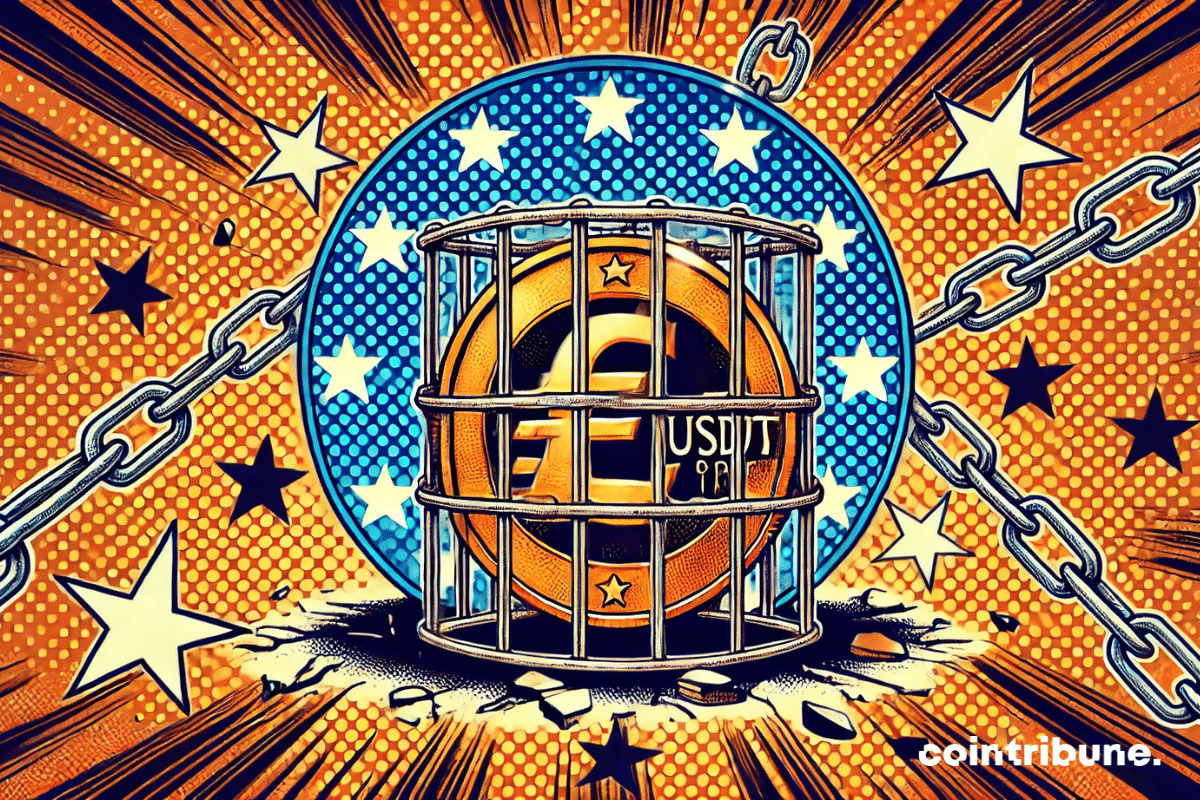20h05 ▪
5
min read ▪ by
The European Union is set to take a major step in crypto regulation with the imminent enforcement of the MiCA (Markets in Crypto-Assets) rules. This initiative, hailed by some as a move towards better transparency and an increased fight against financial abuses, however, triggers intense concerns among industry players. Indeed, the regulation mandates the removal of USDT, the most widely used stablecoin in the world, from regulated platforms within the EU. Such a decision could disrupt the balance of European markets and call into question their attractiveness on the global stage.


The ban on USDT and its immediate impacts
The rules established by the MiCA regulatory framework (Markets in Crypto-Assets), which will come into effect on December 30, 2024, impose strict obligations on stablecoin issuers. Among these requirements are obtaining an electronic money license, maintaining significant reserves, and rigorous supervision of associated transactions. These constraints aim to ensure increased transparency and limit the risks of financial fraud. However, the absence of a license issued to Tether Limited leads to a direct and significant consequence: the removal of USDT, the most widely used stablecoin in the world, from regulated platforms in the European Union.
This withdrawal raises serious concerns due to the central role of USDT in crypto trading. “A large majority of crypto transactions rely on USDT, particularly for its ease of use and low costs,” stated Pascal St-Jean, CEO of 3iQ Corp. The absence of this stablecoin, which serves as the cornerstone for trading pairs worldwide, risks severely disrupting liquidity in European markets. Thus, the first signs of this disruption are already visible. For instance, OKX, a platform that has already removed USDT in Europe, has observed a shift towards fiat currencies and other stablecoins. Despite this transition, alternative solutions are failing to effectively compensate for the void left by USDT. The fragmentation of transactions, coupled with increased costs for investors, intensifies concerns about market fluidity and the region’s competitiveness.
A contested European strategy
While Europe adopts a strict approach towards cryptos, other regions are leaning towards more permissive strategies. In the United States, the recent election of Donald Trump and his pro-crypto policy statements have rekindled investor enthusiasm. This contrast illustrates a clear divergence in geopolitical priorities. While America aims to boost innovation and adoption, Europe emphasizes control and compliance. However, this European choice raises questions about its ability to remain competitive on the global stage.
The figures reflect this critical dynamic. Moreover, venture capital investments in European crypto startups have dropped to their lowest level in four years, reflecting investors’ distrust of a regulatory environment deemed too oppressive. Additionally, MiCA, despite its ambitious goal of regulating the market, could inadvertently encourage operators to migrate to more flexible jurisdictions. This potential talent and capital flight would further weaken an ecosystem already strained by uncertainty and lack of funding.
Beyond the immediate impacts on the markets, this debate provokes a fundamental question: how can Europe reconcile regulation and innovation without compromising its competitiveness? The balance to be struck is delicate. While transparency and stability are essential to strengthen trust in cryptos, imposing overly rigid rules risks stifling technological advancements and limiting the region’s attractiveness to entrepreneurs and investors. This dilemma places Europe in a risky position, the consequences of which could permanently reshape its place in the global digital ecosystem.
The removal of USDT highlights a crucial challenge for Europe: successfully reconciling its ambition for strict regulation with the necessity of remaining competitive in the global digital economy. This decision raises major concerns, ranging from liquidity fragmentation to increased costs for investors. Additionally, there is the threat of an exodus of talent and companies to regions more favorable to innovation. While MiCA represents a decisive step towards harmonized and transparent regulation, its long-term consequences could profoundly alter Europe’s role in a rapidly transforming sector. It remains to be seen whether this regulatory gamble will mean stability or a strategic retreat in the face of more flexible competitors.
Maximize your Cointribune experience with our “Read to Earn” program! For every article you read, earn points and access exclusive rewards. Sign up now and start earning benefits.
Diplômé de Sciences Po Toulouse et titulaire d’une certification consultant blockchain délivrée par Alyra, j’ai rejoint l’aventure Cointribune en 2019.
Convaincu du potentiel de la blockchain pour transformer de nombreux secteurs de l’économie, j’ai pris l’engagement de sensibiliser et d’informer le grand public sur cet écosystème en constante évolution. Mon objectif est de permettre à chacun de mieux comprendre la blockchain et de saisir les opportunités qu’elle offre. Je m’efforce chaque jour de fournir une analyse objective de l’actualité, de décrypter les tendances du marché, de relayer les dernières innovations technologiques et de mettre en perspective les enjeux économiques et sociétaux de cette révolution en marche.
DISCLAIMER
The views, thoughts, and opinions expressed in this article belong solely to the author, and should not be taken as investment advice. Do your own research before taking any investment decisions.










